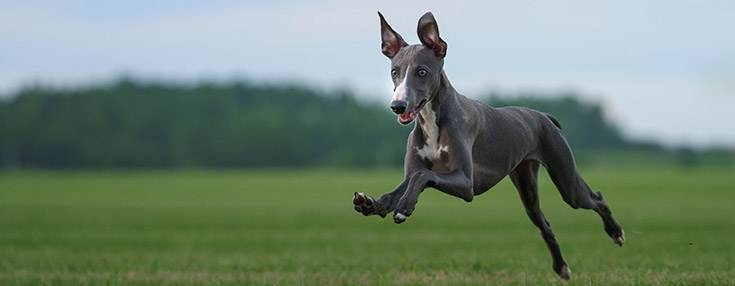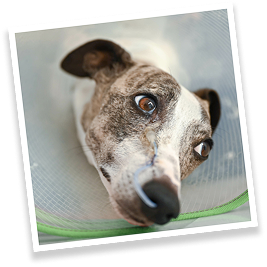
Dog breed – Greyhound
Greyhound
Athletic yet gentle, the Greyhound can make a lovely companion.
Greyhounds at a glance
Sensitive, gentle, easygoing
20-30 minutes of short exercise throughout the day
Life expectancy of 10-14 years
Large, between 27 and 40kg
Greyhound temperament and personality
Greyhounds are very athletic animals, as you can guess by their build. But these dogs are also very gentle, intelligent and quiet.

Greyhound training and exercise
Greyhounds are great to train, as their intelligence and laid-back nature help them adapt quickly to new habits.
This breed of dog also likes to learn through positive reinforcement, including being rewarded with treats.
Surprisingly, Greyhounds don’t need a huge amount of exercise per day. They only need between 20 and 30 minutes of short exercise sessions throughout the day, as they are prone to having short bursts of energy.

Common health conditions in Greyhounds
Greyhounds most commonly suffer from these illnesses:
- periodontal disease
- corns
- bone cancer
- back and neck issues
- spinal issues
- arthritis (this is usually due to old age)
While some of these conditions are genetic or age-related, you can avoid certain illnesses by feeding your Greyhound a healthy diet, taking them for regular vet check-ups and giving them enough exercise and downtime.
Greyhound feeding and nutrition
Like any dog, Greyhounds need a balanced diet of protein, carbohydrates, fats and minerals.
When figuring out which diet is best suited to your greyhound, make sure to introduce any new food or diet gradually, make sure to introduce or any new food or diet gradually. Greyhounds have sensitive stomachs, so sudden changes can result in upset tummies.
Greyhound grooming
Greyhounds have very short coats, so you might not need to use a professional grooming service to keep them in shape.
Brushing them regularly at home is a good idea. Using a ‘hound glove’ can help keep their coat looking healthy too.
As Greyhounds are prone to dental problems, you should check and brush their teeth regularly and take them for regular vet check-ups.

Things to know before you buy or adopt a Greyhound
Before bringing your Greyhound home, there are some important things you should do:
- Get a stock of food ready (along with food and water bowls).
- If you have children, chat with them and get them ready to have a dog in the house.
- Buy a selection of toys to keep your Greyhound entertained indoors.
- Buy a comfy bed that’s spacious enough for your Greyhound.
- Research pet insurance and what your Greyhound needs.
- Buy a comfortable lead or harness.
- Book microchipping and vaccinations.
There are some other things to note before you buy or adopt your Greyhound:
- You shouldn’t over-exercise your Greyhound as they get tired easily.
- You can leave your Greyhound alone for a while.
- Greyhounds have thin skin so are more prone to cuts.
- Greyhounds can be very shy around strangers.
When does a Greyhound stop growing?
Greyhounds stop growing at around 12-18 months old, depending on their full-grown size.
Are Greyhounds good around children?
Greyhounds can be great pals for children as they’re gentle and laid-back.
But they can get stressed easily, so disruptive or hyperactive behaviour may cause them to pull back or become defensive.
This is especially the case if you adopt a racing Greyhound that isn’t used to children’s company.
Are Greyhounds good around other pets?
As Greyhounds are a prey-driven breed (meaning they have a strong chase instinct), it's not recommended that they live in households with cats or other small animals.